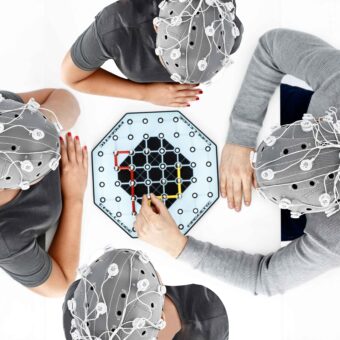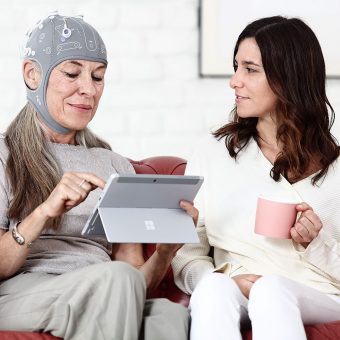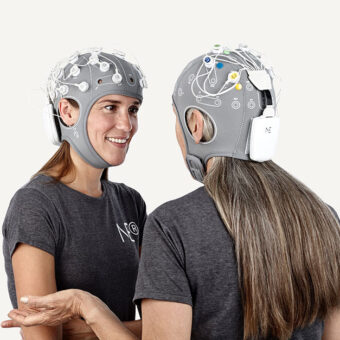At Neuroelectrics, we are pioneering personalized solutions for neurological and neuropsychiatric disorders such as epilepsy, Alzheimer’s disease, and depression. Central to our innovative therapies is brain plasticity, the brain’s ability to adapt and reorganize itself. This blog post explores the mechanisms of brain plasticity, how it interacts with transcranial electrical stimulation (tES), and how we exploit this interaction for therapeutic purposes.
But first, let’s recall what transcranial electrical stimulation is:
Transcranial electrical stimulation (tES)
Transcranial electrical stimulation (tES) is a noninvasive neuromodulation technique that alters cortical network activity by applying weak electric fields through scalp electrodes. Therapeutically, it relies on plasticity to repair circuitry by persistently influencing neural dynamics through repeated sessions over weeks or months [1]. One specific modality of tES, transcranial direct current stimulation (tDCS), has shown promising clinical outcomes in various applications. For example, cathodal tDCS has demonstrated inhibitory effects beneficial for conditions like epilepsy, with studies documenting reductions in seizure frequency and epileptiform activity in both the short-term (minutes to hours post-stimulation) and long-term (days post-stimulation) [2].
Conversely, transcranial alternating current stimulation (tACS) is effective for entraining brain oscillations [3], which can be useful in addressing disorders of oscillatory circuits, such as Alzheimer’s Disease (AD) [4, 5, 6]. Both tDCS and tACS are typically administered in sessions lasting 20-60 minutes, repeated multiple times (10-100 sessions) on different days to achieve long-term clinical benefits.
Understanding Brain Plasticity
Brain plasticity, or neuroplasticity, refers to the brain’s ability to change and adapt in response to experiences, learning, and environmental influences. This dynamic property allows the brain to form new neural connections, strengthen existing ones, reorganize itself to compensate for injuries or adapt to new situations. Plasticity is fundamental to processes such as learning and memory.
Types of Plasticity
Plasticity in the brain can be influenced by various factors, including the number of fibers connecting different brain areas or neuron populations, the number of synapses per fiber, and the state of the synapse, which can be altered by neuromodulatory signals or drugs. Different types of plasticity include [7]:
- Functional or Dynamical Plasticity: This operates on a timescale of milliseconds to minutes and involves changes in the strength or efficiency of synapses. This mechanism is related to short-term and long-term memory, with specific examples including Hebbian plasticity, Long-Term Depression (LTD), and Long-Term Potentiation (LTP) [7].
- Homeostatic Plasticity: This mechanism regulates overall network excitability to maintain stability by adjusting synapse strength to correct excitation-inhibition imbalances. It operates on a slower timescale, ranging from hours to days [8].
- Structural Plasticity: Involves physical changes in neurons, such as synapse formation or dendrite growth, and is related to long-term memory and development.
- Metaplasticity: Often described as the plasticity of synaptic plasticity, metaplasticity represents another layer of complexity and indicates the ability of synapses to change their plasticity rules based on prior activity [9].
Among these plasticity mechanisms, our focus at Neuroelectrics is on two state-dependent plasticity mechanisms: functional plasticity (particularly Hebbian plasticity) and homeostatic plasticity. State-dependent plasticity means that changes in neural connections depend on the current state or activity of the neurons involved [7].
Hebbian Plasticity
Hebbian plasticity [10], summarized as “cells that fire together, wire together,” is based on the principle articulated by Donald Hebb. It suggests that the simultaneous activation of neurons leads to a strengthening of the synaptic connection between them. This mechanism is essential for learning and memory formation.
Hebbian plasticity can be mathematically modeled to show how synaptic strengths evolve based on the activity of pre- and post-synaptic neurons, helping us understand how neural connections change over time based on activity [11].
Homeostatic Plasticity
Homeostatic plasticity is a mechanism that maintains overall network stability by adjusting synaptic strengths to balance excitation and inhibition. This mechanism operates on a slower timescale compared to Hebbian plasticity. It ensures that neural activity remains within a functional range, preventing excessive excitation or inhibition that could lead to dysfunction [12].
Research has shown that excitation-inhibition (E-I) balance is crucial for cortical networks, maintaining the stability of neural circuits.
Plasticity in Neural Mass Models (NMMs)
Neural mass models (NMMs) are simplified representations of large populations of neurons and synapses, described by systems of non-linear ordinary differential equations. While they do not capture individual neuron spikes, NMMs are valuable for modeling brain states and rhythms. They are particularly useful for comparing simulated brain activity with non-invasive data like EEG or fMRI [13].
At Neuroelectrics, we use particularly tuned NMMs that are able to reproduce some pathological features for building whole brain models. For an in-depth discussion on the development and applications of NMMs, check our blog on the emergence of second-generation neural mass models. For more information about whole brain models and how they are built, check our post on neurotwins.
Hebbian Plasticity in NMMs
The integration of Hebbian plasticity mechanisms into NMMs is still an emerging field. There are very few works implementing these mechanisms in NMMs. Most of the existing implementations have focused on single neuron models [14, 15, 16] or second-generation NMMs [17, 18, 19]. Recent studies are, however, beginning to explore the integration of Hebbian plasticity in NMMs. For example, Giannakakis et al. implemented a Hebbian learning rule within a network of coupled Wilson and Cowan NMMs, applying it both within and between brain regions [20]. Similarly, Lea-Carnall et al. adapted Hebbian rules to fit NMMs [21, 22].
Homeostatic Plasticity in NMMs
Homeostatic plasticity mechanisms have seen more extensive implementation in NMMs. Some studies have incorporated these mechanisms into NMMs to investigate their effects on network dynamics and to compare features such as functional connectivity with real data [23, 24]. In Abeysuriya et al. [23], it was shown that inhibitory synaptic plasticity (ISP) successfully achieves a local E-I balance. Additionally, their whole-brain model with ISP could consistently predict functional connectivity computed with real data over a broader range of model parameters compared to models without this homeostatic plasticity mechanism.
Other modeling works have focused on studying the imbalance of excitation and inhibition in lesioned brains, such as those affected by stroke. By constructing whole-brain models of connected Wilson and Cowan NMMs with homeostatic plasticity mechanisms, Páscoa Dos Santos et al. [8] investigated the recovery of certain macroscale features. These studies found that E-I homeostasis helps restore global properties of functional connectivity, relating closely to post-stroke symptomatology [8].
Challenges and Future Directions
There are significantly more studies focusing on the inclusion of homeostatic plasticity in NMMs compared to Hebbian rules. This discrepancy likely arises from the increased complexity and challenges associated with implementing and adapting Hebbian rules to NMMs. Despite substantial progress, the interplay between Hebbian and homeostatic plasticity remains poorly understood. Ongoing discussions among experts highlight that Hebbian and homeostatic mechanisms may function concurrently and potentially interfere with each other within the same subset of synapses [12, 25]. Numerous questions persist, particularly regarding the timescales at which Hebbian and homeostatic plasticity interact, necessitating further research to elucidate these mechanisms and their implications [12].
Our research at Neuroelectrics focuses on integrating these two plasticity mechanisms into our models to understand and enhance the lasting effects of tES. By modeling how tES influences neural activity and incorporating plasticity, we aim to develop therapies that induce long-term beneficial changes in brain function. For that, modeling brain plasticity is crucial.
Stay tuned to our blog for more updates on this research topic!
For more detailed insights, particularly on how we build personalized digital brains you can refer to our previous posts Neurotwins and personalized digital brains and Neurotwins (tES 2.0): Advancing Brain Stimulation, and other related research articles cited throughout this post.
References:
[1] Giulio Ruffini et al. “Transcranial Current Brain Stimulation (tCS): Models and Technologies”. In: IEEE Transactions on Neural Systems and Rehabilitation Engineering 21.3 (May 2013), pp. 333–345. issn: 1534-4320, 1558-0210. doi: 10.1109/TNSRE.2012.2200046.
[2] Daniel San-Juan et al. “Transcranial Direct Current Stimulation in Epilepsy”. eng. In: Brain Stimulation 8.3 (2015), pp. 455–464. issn: 1876-4754. doi: 10.1016/j.brs.2015.01.001.
[3] Daniel Str¨uber and Christoph S. Herrmann. “Modulation of gamma oscillations as a possible therapeutic tool for neuropsychiatric diseases: A review and perspective”. In: International Journal of Psychophysiology 152 (June 2020), pp. 15–25. issn: 0167-8760. doi: 10.1016/j. ijpsycho.2020.03.003.
[4] Giulia Sprugnoli et al. “Impact of multisession 40Hz tACS on hippocampal perfusion in patients with Alzheimer’s disease”. en. In: Alzheimer’s Research & Therapy 13.1 (Dec. 2021), p. 203. issn: 1758-9193. doi: 10.1186/s13195-021-00922-4.
[5] Michele Maiella et al. “Simultaneous transcranial electrical and magnetic stimulation boost gamma oscillations in the dorsolateral prefrontal cortex”. en. In: Scientific Reports 12.1 (Nov. 2022). Publisher: Nature Publishing Group, p. 19391. issn: 2045-2322. doi: 10.1038/s41598- 022-23040-z.
[6] Maeva Dhaynaut et al. “Effects of modulating gamma oscillations via 40Hz transcranial alternating current stimulation (tACS) on Tau PET imaging in mild to moderate Alzheimer’s Disease”. en. In: Journal of Nuclear Medicine 61.supplement 1 (May 2020). Publisher: Society of Nuclear Medicine Section: Neurosciences, pp. 340–340. issn: 0161-5505, 2159-662X.
[7] Giulio Ruffini et al. “Neural Geometrodynamics, Complexity, and Plasticity: A Psychedelics Perspective”. en. In: Entropy 26.1 (Jan. 2024). Number: 1 Publisher: Multidisciplinary Digital Publishing Institute, p. 90. issn: 1099-4300. doi: 10.3390/e26010090. 66
[8] Francisco P´ascoa Dos Santos, Jakub Vohryzek, and Paul F. M. J. Verschure. “Multiscale effects of excitatory-inhibitory homeostasis in lesioned cortical networks: A computational study”. eng. In: PLoS computational biology 19.7 (July 2023), e1011279. issn: 1553-7358. doi: 10 . 1371 / journal.pcbi.1011279.
[9] W. C. Abraham and M. F. Bear. “Metaplasticity: the plasticity of synaptic plasticity”. eng. In: Trends in Neurosciences 19.4 (Apr. 1996), pp. 126–130. issn: 0166-2236. doi: 10.1016/s0166- 2236(96)80018-x.
[10] D. O. Hebb. The Organization of Behavior: A Neuropsychological Theory. New York: Psychology Press, 1940. isbn: 978-1-4106-1240-3. doi: 10.4324/9781410612403.
[11] Wulfram Gerstner. “Hebbian Learning and Plasticity”. en. In: (2011)
[12] Kevin Fox and Michael Stryker. “Integrating Hebbian and homeostatic plasticity: introduction”. en. In: Philosophical Transactions of the Royal Society B: Biological Sciences 372.1715 (Mar. 2017), p. 20160413. issn: 0962-8436, 1471-2970. doi: 10.1098/rstb.2016.0413.
[13] Stephen Coombes. “Next generation neural population models”. English. In: Frontiers in Applied Mathematics and Statistics 9 (Feb. 2023). Publisher: Frontiers. issn: 2297-4687. doi: 10.3389/ fams.2023.1128224.
[14] Friedemann Zenke, Everton J. Agnes, and Wulfram Gerstner. “Diverse synaptic plasticity mechanisms orchestrated to form and retrieve memories in spiking neural networks”. en. In: Nature Communications 6.1 (Apr. 2015). Publisher: Nature Publishing Group, p. 6922. issn: 2041-1723. doi: 10.1038/ncomms7922.
[15] Priyadarshini Panda and Kaushik Roy. “Learning to Generate Sequences with Combination of Hebbian and Non-hebbian Plasticity in Recurrent Spiking Neural Networks”. English. In: Frontiers in Neuroscience 11 (Dec. 2017). Publisher: Frontiers. issn: 1662-453X. doi: 10.3389/ fnins.2017.00693.
[16] Andrew Carnell. “An analysis of the use of Hebbian and Anti-Hebbian spike time dependent plasticity learning functions within the context of recurrent spiking neural networks”. In: Neurocomputing. Brain Inspired Cognitive Systems (BICS 2006) / Interplay Between Natural and Artificial Computation (IWINAC 2007) 72.4 (Jan. 2009), pp. 685–692. issn: 0925-2312. doi: 10.1016/j.neucom.2008.07.012.
[17] Halgurd Taher, Alessandro Torcini, and Simona Olmi. “Exact neural mass model for synapticbased working memory”. eng. In: PLoS computational biology 16.12 (Dec. 2020), e1008533. issn: 1553-7358. doi: 10.1371/journal.pcbi.1008533.
[18] Richard Gast, Thomas R. Kn¨osche, and Helmut Schmidt. “Mean-field approximations of networks of spiking neurons with short-term synaptic plasticity”. en. In: Physical Review E 104.4 (Oct. 2021), p. 044310. issn: 2470-0045, 2470-0053. doi: 10.1103/PhysRevE.104.044310.
[19] Bastian Pietras, Valentin Schmutz, and Tilo Schwalger. “Mesoscopic description of hippocampal replay and metastability in spiking neural networks with short-term plasticity”. en. In: PLOS Computational Biology 18.12 (Dec. 2022). Publisher: Public Library of Science, e1010809. issn: 1553-7358. doi: 10.1371/journal.pcbi.1010809
[20] Emmanouil Giannakakis et al. “Towards simulations of long-term behavior of neural networks: Modeling synaptic plasticity of connections within and between human brain regions”. In: Neurocomputing 416 (Nov. 2020), pp. 38–44. issn: 0925-2312. doi: 10.1016/j.neucom.2020.01.050
[21] Caroline A. Lea-Carnall, Lisabel I. Tanner, and Marcelo A. Montemurro. “Noise-modulated multistable synapses in a Wilson-Cowan-based model of plasticity”. eng. In: Frontiers in Computational Neuroscience 17 (2023), p. 1017075. issn: 1662-5188. doi: 10.3389/fncom.2023.1017075.
[22] Caroline A. Lea-Carnall et al. “Evidence for frequency-dependent cortical plasticity in the human brain”. en. In: Proceedings of the National Academy of Sciences 114.33 (Aug. 2017), pp. 8871– 8876. issn: 0027-8424, 1091-6490. doi: 10.1073/pnas.1620988114.
[23] Romesh G. Abeysuriya et al. “A biophysical model of dynamic balancing of excitation and inhibition in fast oscillatory large-scale networks”. In: PLoS Computational Biology 14.2 (Feb. 2018), e1006007. issn: 1553-734X. doi: 10.1371/journal.pcbi.1006007.
[24] Francesca Castaldo et al. “Multi-modal and multi-model interrogation of large-scale functional brain networks”. In: NeuroImage 277 (Aug. 2023), p. 120236. issn: 1053-8119. doi: 10.1016/ j.neuroimage.2023.120236.
[25] Christos Galanis and Andreas Vlachos. “Hebbian and Homeostatic Synaptic Plasticity—Do Alterations of One Reflect Enhancement of the Other?” In: Frontiers in Cellular Neuroscience 14 (2020). issn: 1662-5102.



